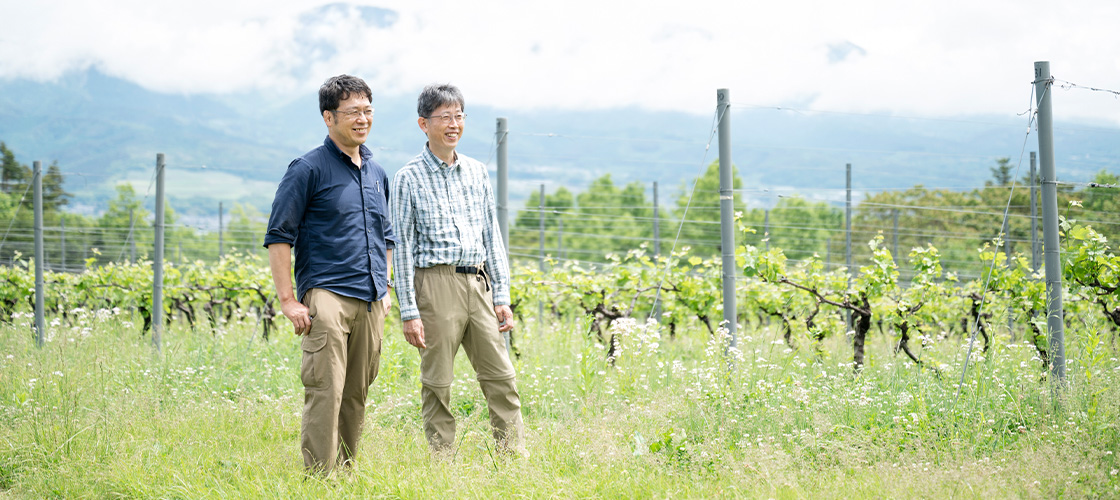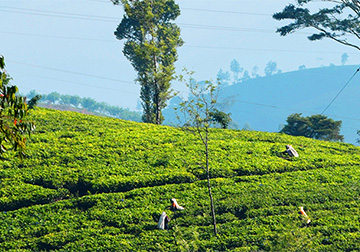Through Making Wine, We Can Also Conserve Nature.
Win-Win Relationships Between Business Activities and Nature ConservationYoshinobu Kusumoto, Specialist in Vegetation and Landscape Ecology
Keiichiro Fujiwara, Environmental Team, CSV Strategy Department, Kirin
“Mariko Vineyard” is a Château Mercian vineyard located on the Jinba plateau in the Maruko district of Ueda City, Nagano Prefecture. For about eight years, Château Mercian and the National Agriculture and Food Research Organization (NARO), a national research institute that conducts research on agriculture, food, farming villages, and the environment in Japan, have been engaged in ecological surveys and vegetation regeneration activities at Mariko Vineyard.
Why are there rich ecosystems in Japan Wine vineyards?
Yoshinobu Kusumoto, an expert in vegetation and landscape ecology, and Keiichiro Fujiwara, who is in charge of environmental communication in the CSV Strategy Department of Kirin, discussed this topic.
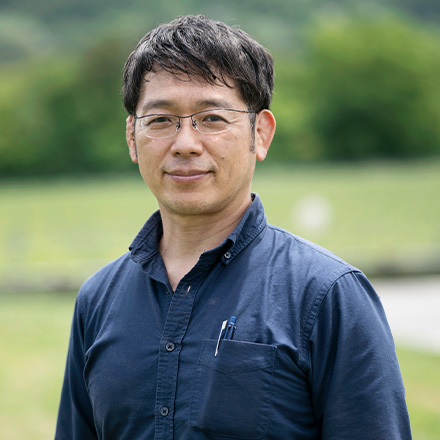
Yoshinobu Kusumoto
Principal Researcher (Ph.D.), National Agriculture and Food Research Organization
Specializes in vegetation and landscape ecology. He researches the development of biodiversity by agriculture. His life work is to contribute to the creation of a sustainable society that balances agricultural production and biodiversity.
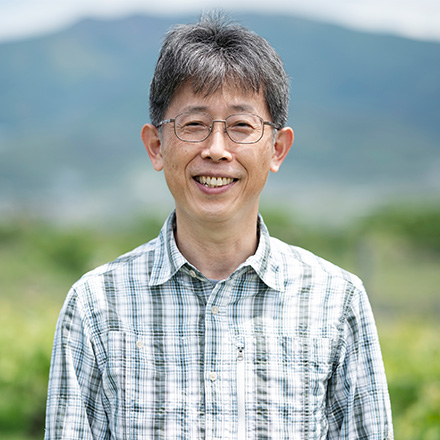
Keiichiro Fujiwara
Environmental Team, CSV Strategy Department, Kirin Holdings Company, Limited
After graduating with a degree in electrical engineering, he worked mainly as a production technology engineer. Since 2006, he has been in charge of environmental management, policy, and strategy formulation for the Kirin Group.
He has served as a member of committees at various ministries and agencies, including being a member of the Ministry of the Environment’s Working Group on the Environmental Reporting Guidelines and the TCFD (*) Guidance by Industry Review Committee.
* TCFD: The Task Force on Climate-related Financial Disclosures was established by the Financial Stability Board, and publishes recommendations to encourage companies to voluntarily disclose information related to the financial impact of climate change risks and opportunities.
Contents
- Reasons for Rich Ecosystems in Vineyards
- The Conservation of Nature as a Side-Effect of “Agriculture.” Win-Win Relationships Between Business Activities and Nature Conservation
- Natural Resilience from “Biodiversity = Abundance of Life”
- Only One Paper as the Sole Prior Material. Finding Our Way to Shrubby Sophora and Shijimiaeoides divinus, a Rare Species
- "Safety and Security" Alone Are Not Enough. Aiming to Become a “Given” for Future Consumers
- The Keyword is Local. Future of "Natural Resources" from a Local Perspective
Reasons for Rich Ecosystems in Vineyards
Q: What was the background to starting an ecological survey here at Mariko Vineyard?
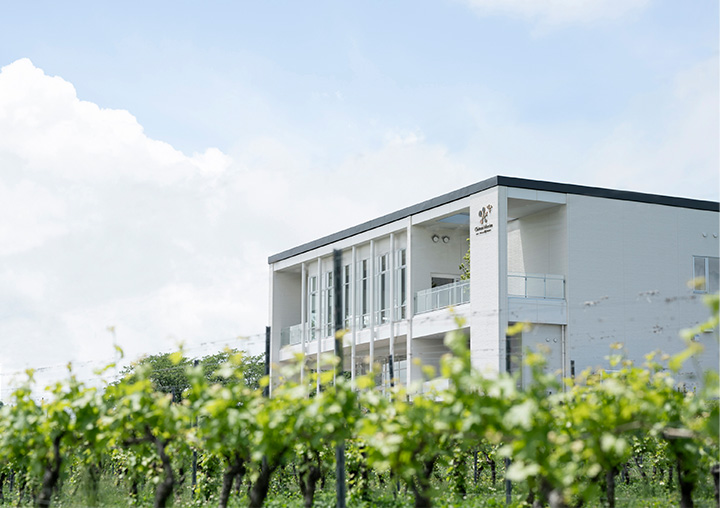
Fujiwara:Château Mercian, which makes Japan Wine, came across this place while looking for a large area it could use to ensure a stable supply of high-quality wine grapes. I heard that, after searching various places, they found the Jinba Plateau in the Maruko district of Ueda City where Mariko Vineyard is located as a place with good sunlight, little precipitation, and excellent drainage and air permeability. At that time, farming on the land had ended and it was left as derelict farmland, but with the cooperation of the local community, it was converted into a vineyard and opened in 2003.
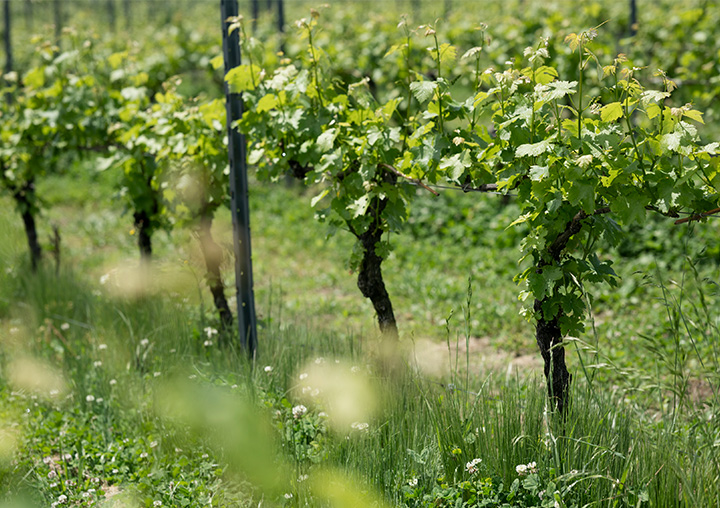
In 2010, the Kirin Group took advantage of the opportunity provided by the Tenth Meeting of the Conference of the Parties to the Convention on Biological Diversity (COP10) in Nagoya to issue a “Declaration of Support for Biodiversity Conservation,” and we began assessing and addressing ecological risks in areas that produce agricultural raw materials for alcoholic and non-alcoholic beverages. Right at this time, the market for Japan Wine was growing and there was talk of expanding vineyards in Japan, such as Mariko Vineyard. Accordingly, we decided to investigate whether turning derelict farmland into vineyards would have a negative impact on the environment. We lacked expertise or experience, so we obtained the assistance of NARO researchers, whom we first asked to study Mariko Vineyard.
I remember vividly when I took the NARO researchers to Mariko Vineyard in the fall of 2014. We got a taxi from Ueda station and went through the countryside and up the Jinba Plateau. Then the moment we saw Mariko Vineyard on our left, the researcher next to me suddenly exclaimed.
“What a great place. I think that if we study this place, we will definitely find rare species and other living things.”
I remember being very surprised that the researcher suddenly told me this.
Partly based on advice from the researchers that it would be better to conduct a proper survey, in 2015, NARO and the Kirin Group began a joint survey of the ecosystem. At first, we were concerned that turning the place into a vineyard might have a negative impact on the environment, but when insect researchers conducted a survey in 2015, they found rare species listed on the Red List of the Ministry of the Environment, and rare species of plants were also found in a vegetation survey in 2016, which surprised us greatly.
At first, these findings just surprised us, but as we progressed with our survey, we gradually realized that turning the derelict farmland into a Japan Wine vineyard had actually enriched the ecosystem.
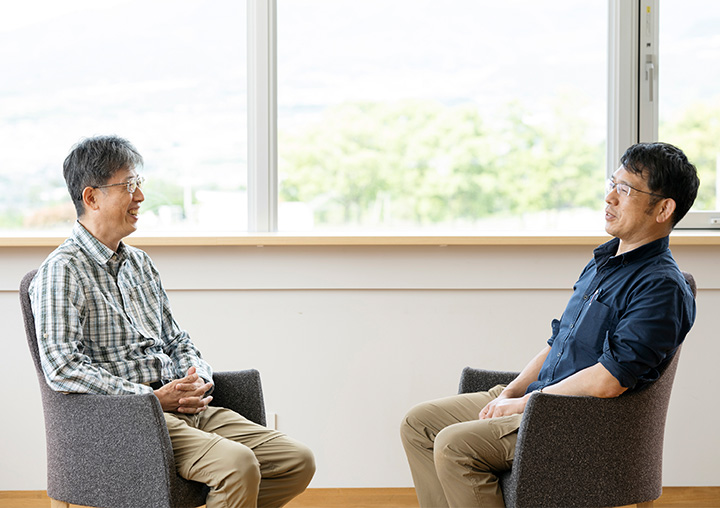
Q: Thinking about it in simple terms, there is an image that ecosystems are preserved when land is left in its natural state... i.e., neglected land, but perhaps human intervention is better for stimulating ecosystems?
Kusumoto:First of all, although we talk about nature as one word, we can broadly classify it into two types of nature. The first is "wilderness.” This is completely untouched nature, without any human intervention. In Japan, however, this makes up only about 9% of total land. The second, "secondary nature," covers another 80% or so of the rest of the country.
The latter, "secondary nature" refers to the nature around us, such as rice fields, fields, and orchards, which has been created mainly by human intervention for agriculture. This type of nature also includes areas such as parks in urban areas, like Shinjuku Gyoen, and vineyards. This type of artificial nature may appear new, but it has developed in line with the course of human progress. In particular, secondary nature associated with agriculture has a history of thousands of years or longer. I think that the "nature" around us that people imagine is what is called Japan’s traditional "Satochi-Satoyama" landscapes, which is exactly what secondary nature refers to.
The Conservation of Nature as a Side-Effect of “Agriculture.” Win-Win Relationships Between Business Activities and Nature Conservation
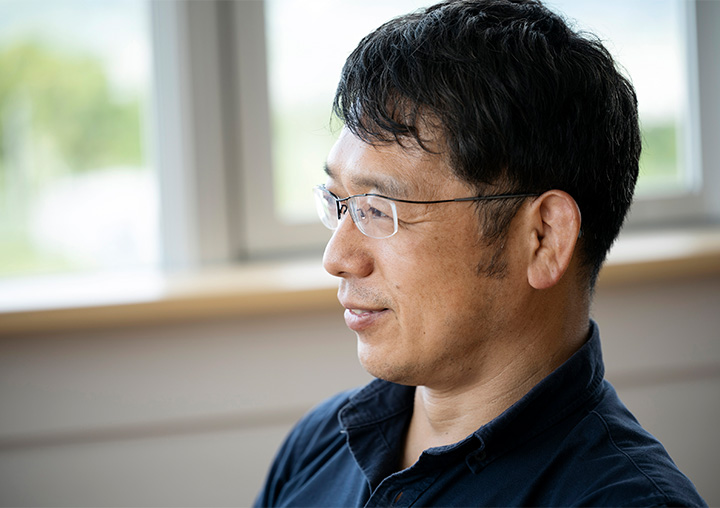
Kusumoto:Within secondary nature, there is a particular focus on grasslands. Grasslands refer to land that is covered with grass, with very few tall trees. The grasslands in Aso City, Kumamoto Prefecture are a famous example. Previous research has shown that grasslands are an excellent environment for nurturing a diverse range of organisms.
In fact, 120 to 130 years ago, about 30% of Japan's land area was grassland. In recent years, however, it has been decreasing rapidly, with recent studies showing that it is already under 1%. In the past, people used grass cut from grasslands for many purposes, such as feed for cattle and horses, fertilizer to be spread and plowed on farmland, and roofing material, but now it has become unnecessary. The maintenance of grasslands, which were once necessary for human life, now faces very difficult circumstances, but the vertical shoot positioning cultivation and hedgerow-style cultivation methods of grapes for wine are protecting and even increasing grasslands.
Vertical shoot positioning cultivation, in which grapevines are grown as if they were a fence, makes it easier for low-growing plants to grow because the shape of the vines allows sunlight to reach the ground. In addition, the removal of undergrowth several times a year enables sunlight to reach native and rare grassland species. In this way, our efforts at Mariko Vineyard have resulted in the formation of a vast grassland of 30 hectares.
Fujiwara:People might say that what we did to produce grapes for wine just happened to be good for the environment, but I think it was significant that we learned that turning derelict farmland into hedgerow-style vineyards was a mechanism for creating grasslands. There was also the fact that the Jinba Plateau itself was a very rich land with high potential.
Kusumoto:The Jinba Plateau, where Mariko Vineyard is located, is a mosaic of these vineyards, copses, rice paddies, ponds, waterways, etc. We benefit greatly from the fact that this land was already a so-called Satoyama environment. From the viewpoint that it was once a good Satoyama landscape, the only thing that was not there was grasslands, which have been supplemented across a large area through the production of grapes, resulting in a perfect natural environment. Moreover, agricultural activities mean that it is extremely rare in Japan today to find a place where grasslands exist across such a large area.
Surveys have generated interesting results showing that, when compared in terms of unit area, secondary nature is actually overwhelmingly richer in terms of living things than wilderness. Secondary nature, however, will be ruined if we do not continue consistently working on it in ways such as agriculture.
For example, if we abandon the farming of fields, certain plants suited to the land will appear and spread. These plants alone will cover a large area of land, meaning that other plants cannot enter.
Recent research has found that when people abandon land that they once cultivated, it rarely immediately returns to natural forest, instead becoming a mere wasteland that is occupied by certain plants. Here at Mariko Vineyard, they cut the grass for the purpose of growing grapes. As a side effect, this also protects nature. This is not difficult and is reasonable, so I think a very good cycle has been created.
Fujiwara:At least as long as Mercian keeps growing grapes, the grasslands here will be protected, alongside nature itself. Producing wine enables us to create grasslands and protects nature. This is a true win-win relationship.
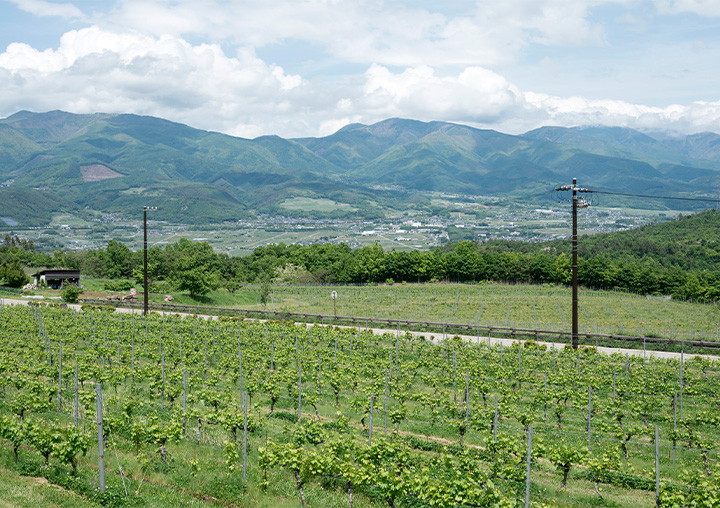
Natural Resilience from “Biodiversity = Abundance of Life”
Q: At Mariko Vineyard, the two of you are currently playing central roles in a research project aimed at conserving biodiversity by protecting and nurturing a diverse range of living things, including rare species found in ecological surveys. Why is the diversity of ecosystems good for crops and the land in the first place?
Kusumoto:Biodiversity is a very broad concept, but to put it simply, it refers to an “abundance of life.” The idea is that the more organisms there are, the better. There are three main reasons.
The first is an ethical reason that a world in which a wide variety of living things can live at the same time is much better than having fewer living things.
Second, diversity at the genetic level is important. For example, the rice, vegetables, meat, and other food we eat are all genetic resources from other living things. Without these genetic resources, humans cannot live. We are able to live thanks to the benefits we receive from this diverse range of living things.
Third, for environmental stability. It is said that if various ecosystems are abundant, their ability to defend against and recover from climate change, disasters, and other major environmental changes will become stronger.
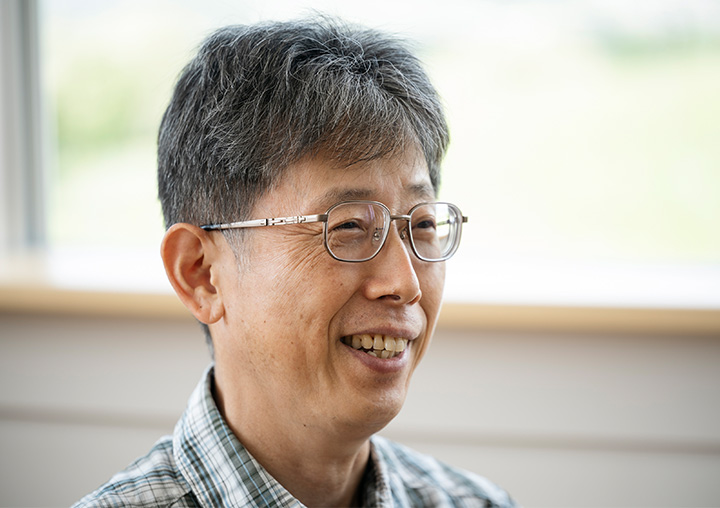
Fujiwara:For example, there is the pollination of flowers. Bees and other insects are responsible for that, but we are not particularly conscious of the fact that bees contribute to pollination on a daily basis. If, however, all the bees suddenly disappear, it will be impossible to produce crops without humans acting as a substitute. But it's impossible for humans to cover all the pollination of flowers in fields around the world.
If all the bees disappear, the environment will immediately undergo drastic change, and we will be unable to avoid food problems, etc. Although we are not usually aware of it, the current state of things is created by the accumulation and interlocking activities of various living things. The ecosystems of this world are complex, and as long as they are preserved, if one part of them is missing, another will make up for it. Biodiversity supports this kind of natural resilience.
Only One Paper as the Sole Prior Material. Finding Our Way to Shrubby Sophora and Shijimiaeoides divinus, a Rare Species
Q: What exactly are you doing in terms of initiatives for the current industry-academia collaboration at Mariko Vineyard?
Fujiwara:We have learned that the cultivation of grapes created grasslands, and this resulted in the protection of diverse ecosystems. As a next step, we started activities to help increase the number of rare and native species that could be found in Mariko Vineyard.
This was because there are some species that, although they still exist, they are extremely few in number or they are vulnerable. Some native plant species, including rare species, are not good at spreading their seeds. So, in fall, we collect dead grass from fields where there are rare or native species and transport it to areas designated for regeneration. There are seeds in the dead grass, so we are helping these plants to spread their seeds. We are continuing such activities.
Kusumoto:Thanks to these efforts, we have been able to confirm the establishment of rare species, and some other native species have almost doubled in number since we started the survey.

Photograph of a rare butterfly, Shijimiaeoides divinus
Fujiwara:We are also focusing on activities to increase the amount of “shrubby sophora,” which is the only food for the larvae of the rare Shijimiaeoides divinus species of butterfly. During the research, we found about 20 plants in the field, but we had to transplant them to make a waterway. Dr. Kusumoto looked into theses related to the transplantation of shrubby sophora, but there was only one. When we read it, it said, “transplantation is possible, but the survival rate is 50%.” When we actually transplanted the plants, 50% did in fact survive. From that experience, we thought that if we try it with cuttings, we might be able to increase the survival rate. We thought that if the amount of shrubby sophora could increase, it might be possible for Shijimiaeoides divinus to live in Mariko Vineyard.
But it was not easy. In any case, there was too little information... and the only option for us was to rely on trial and error in the field.
Kusumoto:Anyway, we did it with the spirit of “trying everything.” That was the only way. However, as a result, we gradually learned the best timing, such as the season for harvesting cuttings, which was previously unknown. Nowadays, it is not difficult for us to grow the plants into cuttings. This is a big step forward when we think about the initial period, when we were fumbling around.
"Safety and Security" Alone Are Not Enough. Aiming to Become a “Given” for Future Consumers
Q: Volunteer activities by elementary school students from the local Shiogawa Elementary School have contributed greatly to the cultivation of shrubby sophora.
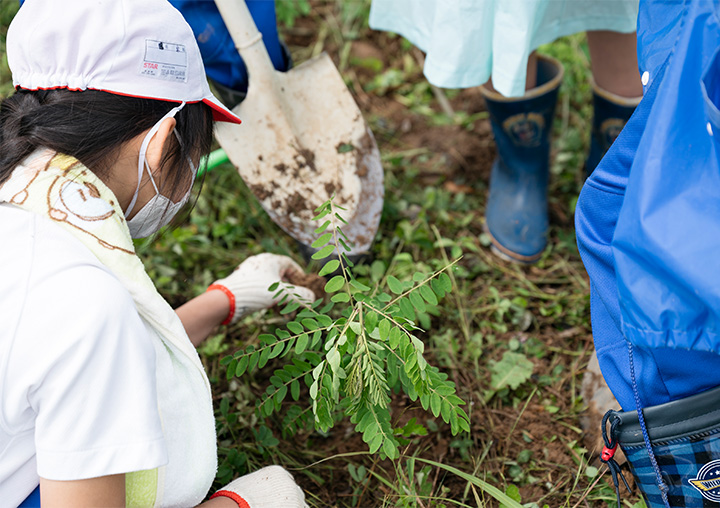
Shrubby sophora, the only food source for the larvae of Shijimiaeoides divinus
Fujiwara:Mercian and Ueda City have a partnership agreement. For that reason, I was asked to hold environmental classes at the elementary school. At that time, I talked about shrubby sophora with the principal, who was very interested and suggested that the elementary school could participate. At the end of last summer, Dr. Kusumoto sent seedlings that had been grown to a condition where they could be planted to the elementary school, and asked them to plant the seedlings in their flower bed. Right at that time, COVID-19 was spreading, and neither Dr. Kusumoto nor I could go there, so I instructed them online using Zoom, and had the children plant the seedlings in the flower bed, which went very well. They grew the seedlings in the flower bed until the end of May this year.
Kusumoto:At the end of May, we had an extracurricular lesson in which we dug out shrubby sophora that had grown larger in the flower bed and replanted it in an area designated for regeneration in Mariko Vineyard. Even when there is a wonderful natural environment around us, we might not realize its value or appreciate it if it is too close to us, but I hope this shrubby sophora planting activity will make the children of Shiogawa Elementary School aware of one of the treasures of the region, namely the nature that surrounds them.
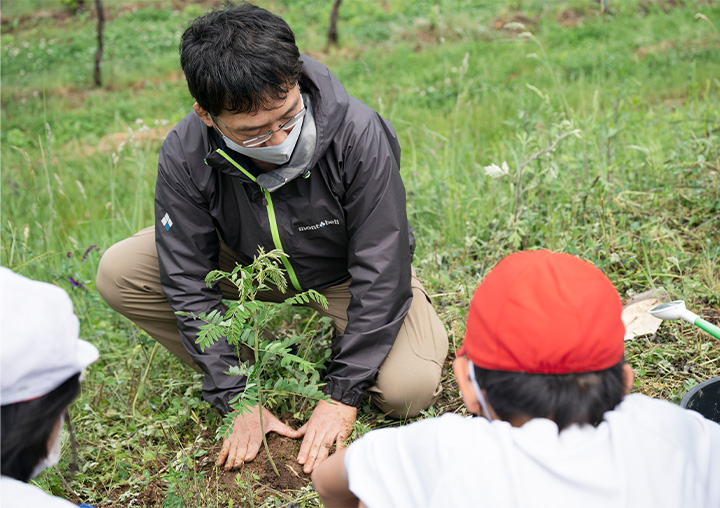
Q: How did the children respond to the actual replanting?
Kusumoto:In fact, last year, after planting the shrubby sophora in the flower bed, the children wrote and sent me their impressions. It was very moving for me.
There were simple childish comments such as "shrubby sophora is very important. I didn't know it was that important," but there were also well thought out opinions such as "I learned that grasslands are decreasing in Japan. It's very nice to have such precious things in the area where we live." I really feel that the plant called shrubby sophora has become an icon and that their understanding of nature is advancing. If these children grow up with this awareness of the environment and living things, I feel the future will be bright. It is also great for the regional community and the company that Mariko Vineyard is a place for living environmental education for the children who will lead the future. I think this is an ideal way to implement CSV (*).
* CSV: Stands for “Creating Shared Value.” It refers to the use of measures to solve social needs and problems to create social and economic value, and to create the next driving force for growth.
Fujiwara:Even though they are a little older than these children, I really feel that young people who are members of the so-called "Generation Z" are already quite conscious of the natural environment. In fact, we hold a workshop for junior and senior high school students called the “Kirin School Challenge,” and when we talk about these matters, I can see that junior and senior high school students have a feeling not like “let’s make a fuss about environmental issues,” but instead feel very naturally that “of course we will protect nature.” I also feel that it is becoming difficult for consumers to buy drinks based only on safety and peace of mind. Consumers are choosing products that take a firm stance toward social issues, and attention is turning toward companies that solve social issues through their businesses. This trend is likely to intensify even more in the future, now that the SDGs have been introduced into the curriculum guidelines for elementary, junior high, and high schools, and are widely covered in classes.
Kusumoto:I also have opportunities to meet Generation Z people at lectures, etc., and I am really surprised when I talk to them. One of the children I talked to before made it clear that they only want to buy products from companies that are properly certified. When I asked why, the child answered in a very interesting way, saying that "it's a cooler lifestyle and more luxurious!”
Fujiwara:For these young people, it is taken as a given that we will properly address environmental problems, and it is not considered to be anything special. Looking at this trend, I feel that if we, as companies, do not solve social issues, including environmental measures, as a matter of course rather than as something special, these young people will refuse to do business with us.
The keyword is Local. Future of "Natural Resources" from a Local Perspective
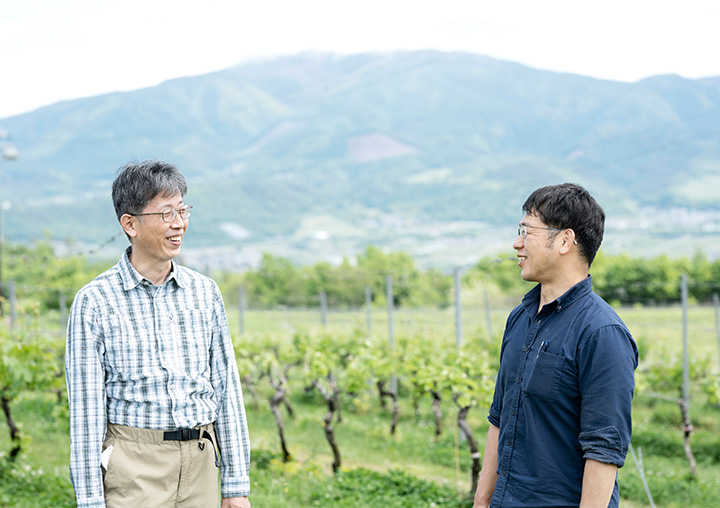
Fujiwara:Having said that, I feel that it is difficult to communicate to people that we are valuing natural capital as we engage in our business activities. For example, in response to climate change, we can set specific numerical targets, such as "how soon can we reduce CO2 emissions to a certain level?" This is difficult, however, with natural capital.
Kusumoto:It is difficult to explain because there is no clear answer. There is no uniform yardstick for judging natural capital and biodiversity.
Fujiwara:Climate change is a global issue. No matter which country or region generates CO2, it spreads into the atmosphere and becomes a common global issue that contributes to global warming. Therefore, there is a consensus that we must not emit CO2, regardless of whether we are in Japan or on the other side of the world. Yet natural capital, i.e., biodiversity, is unique to a certain “place.”
Kusumoto:We cannot speak of it in relative terms. Accordingly, it is also difficult to make up for deficiencies of biodiversity between places.
Fujiwara:For example, we cannot say, "this is fine because although it destroys nature here, it increases it elsewhere." This is because that nature is only in that specific place. Once lost, it cannot be recovered. Recently, we noticed this is easy to understand when described in terms of “terroir.” Taken to an extreme, the grapes of a certain place cannot be substituted with those from vines in a neighboring field. That is a characteristic of natural capital.
Kusumoto:Based on this, I believe that ultimately “local” will become an important keyword when considering natural resources. Being local has its own advantages, so I think it's important to pursue them and recognize each other's merits.
Having said that, human beings understand things by comparing and relativizing, so I think it would be nice if we could eventually establish a yardstick for natural resources. In this regard, I think that we must work hard as researchers. We have no choice but to work steadily toward the future, starting from things that are near to us, from what is local. Activities with the students of Shiokawa Elementary School are also an important step toward this goal.
Fujiwara:That's why it is meaningful to have local people participate in activities related to shrubby sophora. This is an attractive place with precious nature. This activity is aimed at protecting this local nature, which is unique to this place. Accordingly, we want to focus first on working with the local community to maintain this place and make it better.
We also hope to share the knowledge we have gained from this activity with the world. In discussions for the Convention on Biological Diversity, the “30 by 30” international target has been proposed, with the aim of “creating nature protection zones across 30% of land and ocean areas” by 2030. Japan can cover up to about 20% from state-owned land, etc., but it will be necessary to select areas from private land to cover the 10% shortage. I think the hedgerow-style fields of Château Mercian, including Mariko Vineyard, will be sufficiently eligible. “30 by 30” is an international rule, so it will be understood that these fields are rich in nature, not only in Japan but also around the world.
Mariko Vineyard is not a conservation activity like forest conservation activities, but it is characterized by the creation and maintenance of nature through the cultivation of grapes for wine. The same could be said for any hedgerow-style vineyard, provided the correct conditions are in place. When I started this activity, I promised Dr. Kusumoto and NARO that we would not monopolize the expertise we gain from this place, but that instead we will publish it in large quantities through our website, papers, etc. This is because I hope that other vineyards will use whatever knowledge they can, and that all the vineyards in Japan will create and maintain the nature of Japan. Nothing would make me happier than if our trial and error at Mariko Vineyard ultimately helped improve the overall value of Japan Wine.
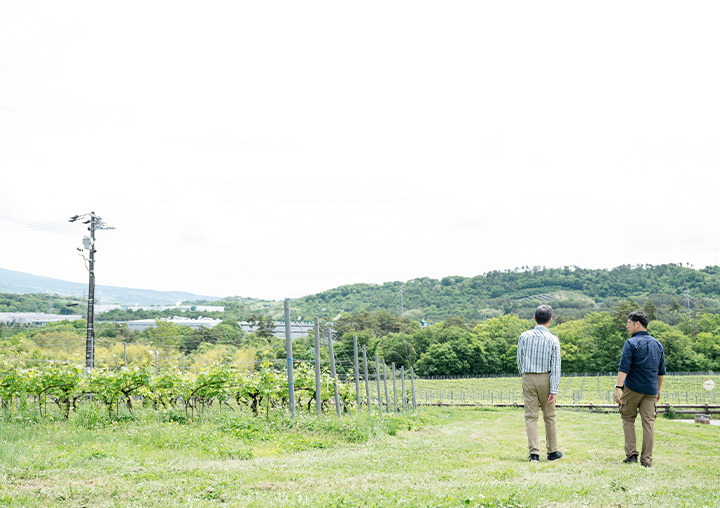
About the Château Mercian Mariko Winery and Mariko Vineyard

Hironori Kobayashi, Manager of Château Mercian Mariko Winery
Mariko Vineyard, which opened in 2003 in Ueda City, Nagano Prefecture, is the field managed by Mercian the size of about six Tokyo Domes. Mercian grows eight types of grapes at the vineyard using vertical shoot positioning cultivation, including “Merlot,” “Chardonnay,” “Syrah,” and “Sauvignon Blanc.” In 2019, we opened the “Château Mercian Mariko Winery” on a small hill in the vineyard, where visitors can see the entire processes from the cultivation of grapes to winemaking.
“Mariko Winery,” which we created together with the people of Ueda City, has won significant praise, including being the only vineyard in Japan to be selected as one of the “World’s Best Vineyards” in the “World’s Top 50 Wineries” for two consecutive years.
We will continue to place importance on coexistence with local communities, nature, and the future, and endeavor to grow grapes and make wine with the passion to “make Mariko, Château Mercian, and Japan world-famous wine-making regions."
We also have winery tours, so we urge readers to visit and enjoy our wine and nature.
Release date: June 22, 2022
* The content, affiliations, titles, etc., are as of the time of release.
- Photography:Wakana Baba
- Text:Chikara Tsujimoto
- Editing:RIDE MEDIA & DESIGN


